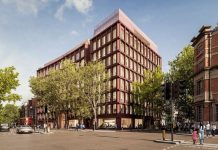MSCI’s latest Quarterly Index indicates that Total Returns have stabilised at 2.2% for All Property across the past two quarters, driven by a return to positive Capital Growth alongside perennially stable Income Return levels, as outlined in BNP Paribas Real Estate’s Q1 2017 UK investment report:
As has been the case for some time now, certain sectors’ outperformance has counterbalanced the weaker performance of others. Industrial continues to surpass the rest of the UK sectors, with Q1 2017 Total Returns standing at 3.8%, exceeding the Retail and Office sectors which both posted returns of 1.7%.
In positive news, Q1 2017 saw all UK property types record positive capital growth for the first time since Q3 2014, including the struggling Supermarket sector, although this was still resolutely weak at 0.1%.
Above are all positive signs that the UK property market is stabilising following the shocks and falls witnessed post-EU Referendum. Although political uncertainty continues, arguably the UK’s current situation is “less uncertain” than in recent months, with Article 50 now triggered and the Brexit process officially underway.
Whilst a new General Election has been called, perhaps counter intuitively this could be cited as a move towards greater stability. Neither of the two main political parties are campaigning to backtrack on the UK’s decision to leave the European Union, meaning the potential for further UK-centric political shocks is low. The snap nature of this election should also serve to lessen any potential impact.
Q1 2017 total UK investment volumes are slightly down on the ten year quarterly average, however both 2014 and 2015 constituted exceptional years, which have skewed the average to a certain extent.
Despite overall volumes remaining fairly in line with the previous quarter, the volume of deals recorded fell substantially, indicating a current trend towards trophy asset and high capital acquisitions.
The Central London market is a key example of this. The capital had an overwhelmingly positive quarter, accounting for £4.75 billion across all sectors, 17% above its long term average and a substantial recovery from the decline recorded immediately post-EU Referendum. Much of this total was driven by high value office transactions to Overseas Investors, including the sale of trophy asset The Leadenhall Building to Hong Kong investor CC Land (£1.15bn). Overseas Investors in fact accounted for 79% of transactional activity in the capital, the highest quarterly share since our records began.
Based on figures from Property Data, at an All Property level Overseas Investors remained substantial net purchasers in UK property over Q1 2017 versus Q1 2016. UK Institutions have switched to become net sellers, with UK retail funds holding increasing amounts of cash to mitigate future redemptions, however this will result in a cash drag on performance. Quoted Property Companies and REITS have moved from a balanced position to become net sellers over this first quarter.
Overseas Investors have overwhelmingly targeted core assets, predominantly Central London offices. However, they also continued to deploy money regionally, accounting for circa 35% of total spend outside London, compared to 33% witnessed in Q1 2016. The most notable deal saw a pool of overseas clients of HSBC Alternative Investments (HAIL) buying a portfolio of assets, including 470,000 sq ft of Grade A offices, at Brindleyplace in Birmingham for around £260 million at a net initial yield of 6%.
Additionally overseas money has shown increased interest in alternative sectors as part of an effort to rebalance their portfolio allocation. There is also some evidence that Overseas Investors are still taking selective steps up the risk curve both in the capital and in the regions, although at a much reduced level to the same quarter in 2016.
Investment strategies have varied across investor nationalities. In terms of overseas investor origin Asia-Pacific funds (45%) were the most active across all UK property, followed by European (24%) and North American (17%). Asia-Pacific investors have largely pursued well-let, prime office assets predominantly located in Central London, and whilst the same is broadly true of other nationalities, a number of investments concerning European and North American investors have concerned the acquisition of alternative use classes. A key example comprises Brookfield Asset Management’s purchase of the Unite Portfolio, totalling 13 student residential properties, for £295m.
UK Institutions, Quoted Property Companies and REITS have conversely been selling a number of core holdings, and instead have made some investment, although limited, in alternatives. For example, DTZ Investors’ acquisition of key Manchester city centre leisure destination The Printworks for £108m, reflecting a 5.9% net initial yield.
Retail funds continue to have a relatively cautious approach over this part of the cycle. Whilst retail fund withdrawals have stabilised following post referendum outflows, most of the UK retail funds have seen net inflows in Q1.
One of the key stories over the latter half of 2016 was the rise in activity from Local Authorities. Whilst they continue to be acquisitive, the pace has slowed, with Q1 recording £200m over nine transactions, all of which are located outside London. Their activity was not solely concentrated within their respective jurisdictions, however, with increased confidence in the UK market leading them to search for income outside their locale. One of the latest examples is the acquisition of 201 Deansgate in Manchester by Essex CC Superannuation for c. £29 million at a rumoured net initial yield of 3.6%.

















